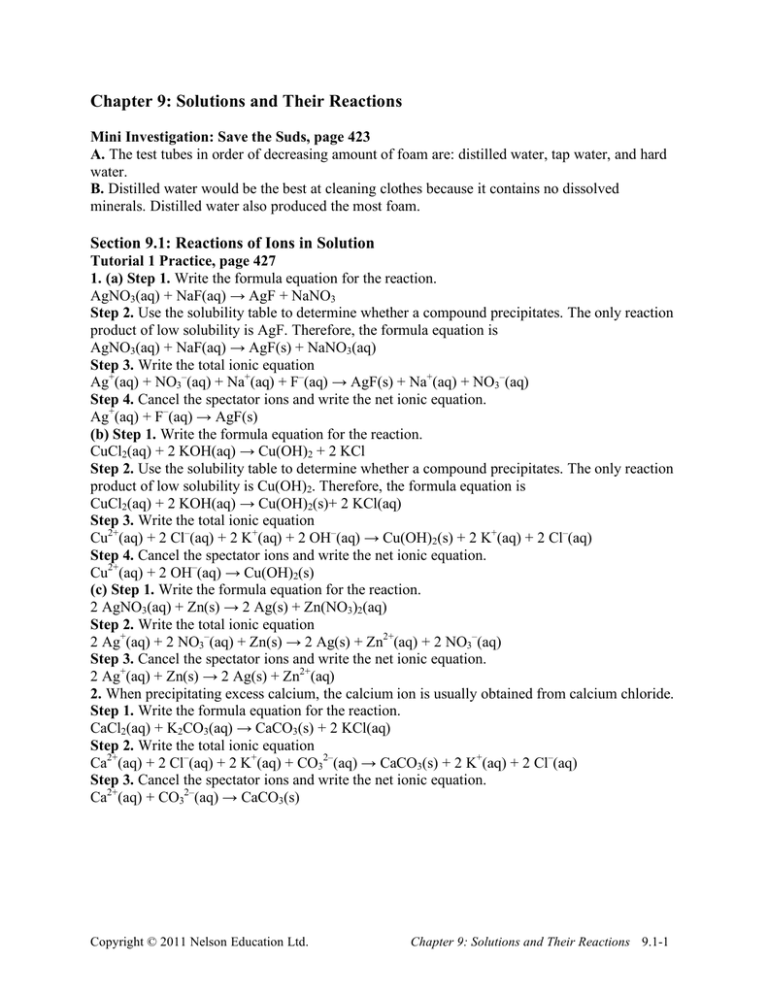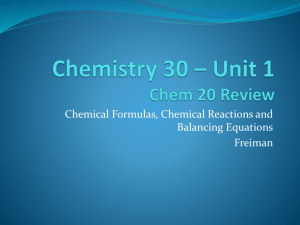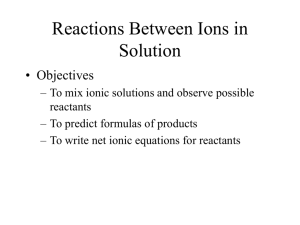Chapter 9: Solutions and Their Reactions
advertisement

Chapter 9: Solutions and Their Reactions Mini Investigation: Save the Suds, page 423 A. The test tubes in order of decreasing amount of foam are: distilled water, tap water, and hard water. B. Distilled water would be the best at cleaning clothes because it contains no dissolved minerals. Distilled water also produced the most foam. Section 9.1: Reactions of Ions in Solution Tutorial 1 Practice, page 427 1. (a) Step 1. Write the formula equation for the reaction. AgNO3(aq) + NaF(aq) → AgF + NaNO3 Step 2. Use the solubility table to determine whether a compound precipitates. The only reaction product of low solubility is AgF. Therefore, the formula equation is AgNO3(aq) + NaF(aq) → AgF(s) + NaNO3(aq) Step 3. Write the total ionic equation Ag+(aq) + NO3–(aq) + Na+(aq) + F–(aq) → AgF(s) + Na+(aq) + NO3–(aq) Step 4. Cancel the spectator ions and write the net ionic equation. Ag+(aq) + F–(aq) → AgF(s) (b) Step 1. Write the formula equation for the reaction. CuCl2(aq) + 2 KOH(aq) → Cu(OH)2 + 2 KCl Step 2. Use the solubility table to determine whether a compound precipitates. The only reaction product of low solubility is Cu(OH)2. Therefore, the formula equation is CuCl2(aq) + 2 KOH(aq) → Cu(OH)2(s)+ 2 KCl(aq) Step 3. Write the total ionic equation Cu2+(aq) + 2 Cl–(aq) + 2 K+(aq) + 2 OH–(aq) → Cu(OH)2(s) + 2 K+(aq) + 2 Cl–(aq) Step 4. Cancel the spectator ions and write the net ionic equation. Cu2+(aq) + 2 OH–(aq) → Cu(OH)2(s) (c) Step 1. Write the formula equation for the reaction. 2 AgNO3(aq) + Zn(s) → 2 Ag(s) + Zn(NO3)2(aq) Step 2. Write the total ionic equation 2 Ag+(aq) + 2 NO3–(aq) + Zn(s) → 2 Ag(s) + Zn2+(aq) + 2 NO3–(aq) Step 3. Cancel the spectator ions and write the net ionic equation. 2 Ag+(aq) + Zn(s) → 2 Ag(s) + Zn2+(aq) 2. When precipitating excess calcium, the calcium ion is usually obtained from calcium chloride. Step 1. Write the formula equation for the reaction. CaCl2(aq) + K2CO3(aq) → CaCO3(s) + 2 KCl(aq) Step 2. Write the total ionic equation Ca2+(aq) + 2 Cl–(aq) + 2 K+(aq) + CO32–(aq) → CaCO3(s) + 2 K+(aq) + 2 Cl–(aq) Step 3. Cancel the spectator ions and write the net ionic equation. Ca2+(aq) + CO32–(aq) → CaCO3(s) Copyright © 2011 Nelson Education Ltd. Chapter 9: Solutions and Their Reactions 9.1-1 Section 9.1 Questions, page 428 1. (a) formula equation: ZnCl2(aq) + K2CO3(aq) → ZnCO3(s) + 2 KCl(aq) total ionic equation: Zn2+(aq) + 2 Cl–(aq) + 2 K+(aq) + CO32–(aq) → ZnCO3(s) + 2 K+ + Cl–(aq) net ionic equation: Zn2+(aq) + CO32–(aq) → ZnCO3(s) (b) formula equation: Fe(NO3)3(aq) + 3 NaOH(aq) → Fe(OH)3(s) + 3 NaNO3(aq) total ionic equation: Fe3+(aq) + 3 NO3–(aq) + 3 Na+(aq) + 3 OH–(aq) → Fe(OH)3(s) + 3 Na+(aq) + 3 NO3–(aq) net ionic equation: Fe3+(aq) + 3 OH–(aq) → Fe(OH)3(s) (c) Cu(NO3)2(aq) + Al(s) → Cu(s) + Al(NO3)2(aq) total ionic equation: Cu2+(aq) + 2 NO3–(aq) + Al(s) → Cu(s) + Al2+(aq) + 2 NO3–(aq) net ionic equation: Cu2+(aq) + Al(s) → Cu(s) + Al2+(aq) 2. (a) formula equation: Sn(s) + 2 AgNO3(aq) → Sn(NO3)2(aq) (s) + 2 Ag(s) (b) net ionic equation: Sn(s) + 2 Ag+(aq) → Sn2+(aq) + 2 Ag(s) (c) Carbonate ions can be used to precipitate tin(II) ions from the solution. A soluble carbonate compound that could be used is potassium carbonate. (d) net ionic equation: Sn2+(aq) + CO32–(aq) → SnCO3(s) 3. (a) lowest solubility: FeS; spectator ions: Na+(aq) and Br–(aq) net ionic equation: Fe2+(aq) + S2–(aq) → FeS(s) (b) lowest solubility: BaCO3; spectator ions: NH4+(aq) and OH–(aq) net ionic equation: Ba2+(aq) + CO32–(aq) → BaCO3(s) 4. The term “spectator” was chosen to describe spectator ions because spectators at a sporting event are not active participants in the event. Similarly, spectator ions are ions that are present but do not participate in the chemical reaction. 5. Step 1. Write the formula equation for the reaction. Use the solubility table to determine whether a compound precipitates. Cl2(g) + 2 KI(aq) → I2(s) + 2 KCl(aq) Step 2. Write the total ionic equation. Cl2(g) + 2 K+ + 2 I–(aq) → I2(s) + 2 K+ + 2 Cl–(aq) Step 3. Write the net ionic equation. Cl2(g) + 2 I–(aq) → I2(s) + 2 Cl–(aq) 6. (a) Two compounds that may be used to precipitate the iron from the water are sodium hydroxide and potassium hydroxide. (b) Fe3+(aq) + 3 OH–(aq) → Fe(OH)3(s) 7. Step 1. Write the formula equation for the reaction. Use the solubility table to determine whether a compound precipitates. 2 NaCl(aq) + 2 H2O(l) electricity !!!!!!!!!!" Cl2(g) + H2(g) + 2 NaOH(aq) Step 2. Write the total ionic equation. 2 Na+(aq) + 2 Cl–(aq) + 2 H2O(l) → Cl2(g) + H2(g) + 2 Na+(aq) + 2 OH–(aq) Step 3. Write the net ionic equation. 2 Cl–(aq) + 2 H2O(l) → Cl2(g) + H2(g) + 2 OH–(aq) 8. (a) Three suitable compounds that could be dissolved in water to make a solution that contains aqueous phosphate ions are sodium phosphate, potassium phosphate, and ammonium phosphate. (b) 3 Ca2+(aq) + 2 PO43–(aq) → Ca3(PO4)2(s) 9. (a) 2 Al(s) + 3 CuCl2(aq) → 3 Cu(s) + 2 AlCl3(aq) (b) Answers may vary. Sample answer: A soluble compound that could be used to precipitate the aluminum ions is sodium phosphate. Copyright © 2011 Nelson Education Ltd. Chapter 9: Solutions and Their Reactions 9.1-2 10. (a) Step 1. Write the formula equation for the reaction. Ca(aq) + C2O4(aq) → CaC2O4(s) Step 2. Write the total ionic equation. Ca2+(aq) + C2O42–(aq) → CaC2O4(s) Step 3. Write the net ionic equation. Ca2+(aq) + C2O42–(aq) → CaC2O4(s) (b) The symptoms of kidney stones are severe pain in the lower back, blood in the urine, and nausea and vomiting. There are several factors that lead to the formation of kidney stones, including certain medications, consuming too much vitamin C, blockage of the urinary tract, not drinking enough fluids, and consuming too much calcium oxalate or foods that are high in uric acid. (c) Answers may vary. Sample answer: Most kidney stones pass through the body as long as the person follows a special diet and drinks plenty of fluids. Stones that do not pass through the body may become lodged in the ureter and need to be removed using either surgery or extra-corporeal shock wave lithotripsy (ESWL). ESWL uses high energy shock waves to break up the kidney stone into small enough pieces that can pass through the ureter. Some types of kidney stones can be dissolved using medications. Copyright © 2011 Nelson Education Ltd. Chapter 9: Solutions and Their Reactions 9.1-3





